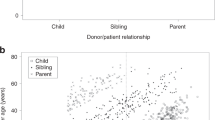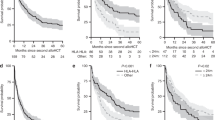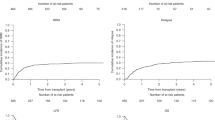Summary:
Treatment options for persons with leukemia relapsing after allogeneic transplantation are limited. We analyzed the outcome of 279 patients with acute and chronic leukemia, who relapsed after HLA-identical sibling transplantation and received a second allogeneic transplant. The influence of potential risk factors on treatment-related mortality (TRM), relapse, treatment failure (relapse or death) and overall survival after second transplantation were assessed using proportional-hazards regression. The cumulative incidences (95% confidence interval) of relapse and TRM at 5 years were 42 (36–48)% and 30 (24–36)%, respectively. The 5-year probabilities of both overall and leukemia-free survival were 28 (23–34)%. In multivariate analyses, risks of treatment failure and mortality were lower in younger patients (⩽20 years) and patients who relapsed after 6 months from first transplantation. Risks of relapse were lower in patients who relapsed after 6 months from first transplantation and in complete remission prior to second transplantation. Risks of relapse were higher after reduced-intensity conditioning regimens. Any potential advantage of using a different matched related donor for a second transplantation is not supported by these data. Although age, disease status and conditioning regimen are important, duration of remission after first transplantation appear to be the most important determinant of outcome.
This is a preview of subscription content, access via your institution
Access options
Subscribe to this journal
Receive 12 print issues and online access
$259.00 per year
only $21.58 per issue
Buy this article
- Purchase on Springer Link
- Instant access to full article PDF
Prices may be subject to local taxes which are calculated during checkout



Similar content being viewed by others
References
Mrsic M, Horowitz MM, Atkinson K et al. Second HLA-identical sibling transplants for leukemia recurrence. Bone Marrow Transplant 1992; 9: 269–275.
Kumar L . Management of relapse after allogeneic bone marrow transplantation. J Clin Oncol 1994; 7: 50–57.
Bosi A, Laszlo D, Labopin M et al. Second allogeneic bone marrow transplantation in acute leukemia: results of a survey by the European cooperative group for blood and marrow transplantation. J Clin Oncol 2001; 9: 3675–3684.
Mackinnon S, Papadopoulos EB, Carabasi MH et al. Adoptive immunotherapy evaluating escalating doses of donor leukocytes for relapse of chronic myeloid leukemia after bone marrow transplantation: separation of graft-versus-host disease. Blood 1995; 86: 1261–1268.
Bacigalupo A, Soracco M, Vassallo F et al. Donor lymphocyte infusion (DLI) in patients with chronic myeloid leukemia following allogeneic bone marrow transplantation. Bone Marrow Transplant 1995; 19: 927–932.
Collins RH, Shpilberg O, Drobyski WR et al. Donor leukocyte infusions in 140 patients with relapsed malignancy after allogeneic bone marrow transplantation. J Clin Oncol 1997; 15: 433–444.
Dazzi F, Szydlo R, Goldman J et al. Donor lymphocyte infusions for relapse of chronic myeloid leukemia after allogeneic stem cell transplant: Where we now stand. Exp Haematol 1999; 27: 1477–1486.
Dazzi F, Szydlo RM, Cross NCP et al. Durability of responses following donor lymphocyte infusions for patients who relapse after allogeneic stem cell transplantation for chronic myeloid leukemia. Blood 2000; 96: 2712–2716.
Porter DL, Collins RH, Hardy C et al. Treatment of relapsed leukemia after unrelated donor marrow transplantation with unrelated donor leukocyte infusions. Blood 2000; 95: 1214–1221.
Carlens S, Remberger M, Ascham J, Ringdén O . The role of disease stage in the response to donor lymphocyte infusions as treatment for leukemic relapse. Biol Blood Marrow Transplant 2001; 7: 31–38.
Levine JE, Braun T, Penza SL et al. Prospective trial of chemotherapy and donor leukocyte infusions for relapse of advanced myeloid malignancies after allogeneic stem cell transplant. J Clin Oncol 2000; 20: 405–412.
Kantarjian HM, O'Brien S, Cortes JE et al. Imatinib mesylate therapy for relapse after allogeneic stem cell transplantation for chronic myelogenous leukemia. Blood 2000; 100: 1590–1595.
Barrett AJ, Locatelli F, Treleaven JG et al. Second transplants for leukemic relapse after bone marrow transplantation: high early mortality but favorable effect of chronic GVHD on continued remission. Br J Haematol 1991; 79: 567–574.
Wagner JE, Vogelsang GB, Zehnbauer BA et al. Relapse of leukemia after bone marrow transplantation: effect of second myeloabalative therapy. Bone Marrow Transplant 1992; 9: 205–209.
Radich JP, Sanders JE, Buckner CD et al. Second allogeneic transplantation for patients with recurrent leukemia after initial transplantation with total body irradiation-containing regimen. J Clin Oncol 1993; 11: 304–313.
Martino R, Badell I, Brunet S et al. Second bone marrow transplantation for leukemia in untreated relapse. Bone Marrow Transplant 1994; 14: 589–593.
Chaing K-Y, Weisdorf DJ, Davies SM et al. Outcome of second bone marrow transplantation following a uniform conditioning regimen as therapy for malignant relapse. Bone Marrow Transplant 1996; 17: 39–42.
Bosi A, Bacci S, Miniero R et al. Second allogeneic bone marrow transplantation in acute leukemia: a multicenter study from the Gruppo Italiano Trapianto Di Midollo Osseo (GITMO). Leukemia 1997; 11: 420–424.
Kishi K, Takahashi S, Gondo H et al. Second allogeneic bone marrow transplantation for post-transplant leukemia relapse: results of a survey of 66 cases in 24 Japanese institutes. Bone Marrow Transplant 1997; 19: 461–466.
Michallet M, Tanguy ML, Socie G et al. Second allogeneic heamtopoietic transplantation in relapsed acute and chronic leukemias for patients who underwent a first allogeneic bone marrow transplantation: a survey of the Societe Francaise de Greffe de Moelle (SFGM). Br J Haematol 2000; 108: 400–407.
Tomonari A, Iseki T, Ooi J et al. Second allogeneic hematopoietic stem cell transplantation for leukemia relapse after first allogeneic transplantation: outcome of 16 patients in a single institution. Int J Hematol 2002; 75: 318–323.
Glucksberg H, Storb R, Fefer A et al. Clinical manifestations of graft-versus-host disease in human recipients of marrow from HLA-identical sibling donors. Transplantation 1974; 18: 295–304.
Przepiorka D, Weisdorf D, Martin P et al. Consensus conference on acute GVHD grading. Bone Marrow Transplant 1995; 15: 825–828.
Atkinson K, Horowitz MM, Gale RP et al. Risk factors for chronic graft-versus-host disease after HLA-identical sibling bone marrow transplantation. Blood 1990; 75: 2459–2464.
Klein JP, Moeschberger ML . Survival Analysis: Techniques of Censored and Truncated Data. Springer-Verlag: New York, NY, 2003.
Cox DR . Regression models and life tables. J R Stat Soc Ser B 1972; 34: 187–202.
Andersen PK, Klein JP, Zhang M-J . Testing for center effects in multi-center survival studies: a Monte Carlo comparison of fixed and random effects tests. Stat Med 1999; 18: 1489–1500.
Clark TG, Altman DG, De Stavola BL . Quantification of the completeness of follow up. Lancet 2001; 359: 1309–1310.
Giralt S, Estey E, Albitar et al. Engraftment of allogeneic progenitor cells with purine analog-containing chemotherapy: harnessing graft-versus-leukemia without myeloablative therapy. Blood 1997; 89: 4531–4536.
Pawson R, Potter MN, Theocharous P et al. Treatment of relapse after allogeneic bone marrow transplantation with reduced intensity conditioning (FLAG±Ida) and second allogeneic stem cell transplant. Br J Haematol 2001; 115: 622–629.
Champlin RE, Schmitz N, Horowitz MM et al. Blood stem cells compared with bone marrow as a source of hematopoietic cells for allogeneic transplantation. Blood 2000; 95: 3702–3709.
Bensinger WI, Martin PJ, Storer B et al. Transplantation of bone marrow as compared with peripheral blood cells from HLA-identical relatives in patients with hematologic cancers. N Engl J Med 2001; 344: 175–181.
Acknowledgements
This work was supported by a Clinical Research Career Development Award from the American Society of Clinical Oncology (ME), Public Health Service Grant U24-CA76518 from the National Cancer Institute, the National Institute of Allergy and Infectious Diseases, the National Heart, Lung and Blood Institute and the Cancer Center, Medical College of Wisconsin.
Author information
Authors and Affiliations
Corresponding author
Rights and permissions
About this article
Cite this article
Eapen, M., Giralt, S., Horowitz, M. et al. Second transplant for acute and chronic leukemia relapsing after first HLA-identical sibling transplant. Bone Marrow Transplant 34, 721–727 (2004). https://doi.org/10.1038/sj.bmt.1704645
Received:
Accepted:
Published:
Issue Date:
DOI: https://doi.org/10.1038/sj.bmt.1704645
Keywords
This article is cited by
-
Thiotepa–fludarabine–treosulfan conditioning for 2nd allogeneic HCT from an alternative unrelated donor for patients with AML: a prospective multicenter phase II trial
Bone Marrow Transplantation (2022)
-
Relapse of acute leukemia after a second allogeneic stem- cell transplantation; Is there any hope for cure?
Bone Marrow Transplantation (2022)
-
Outcomes of third allogeneic hematopoietic stem cell transplantation in relapsed/refractory acute leukemia after a second transplantation
Bone Marrow Transplantation (2022)
-
Outcomes in patients with acute lymphoblastic leukemia who underwent second allogeneic hematopoietic cell transplantation for relapse after first transplantation
International Journal of Hematology (2022)
-
Relapse after allogeneic hematopoietic stem cell transplantation in acute myeloid leukemia: an overview of prevention and treatment
International Journal of Hematology (2022)



